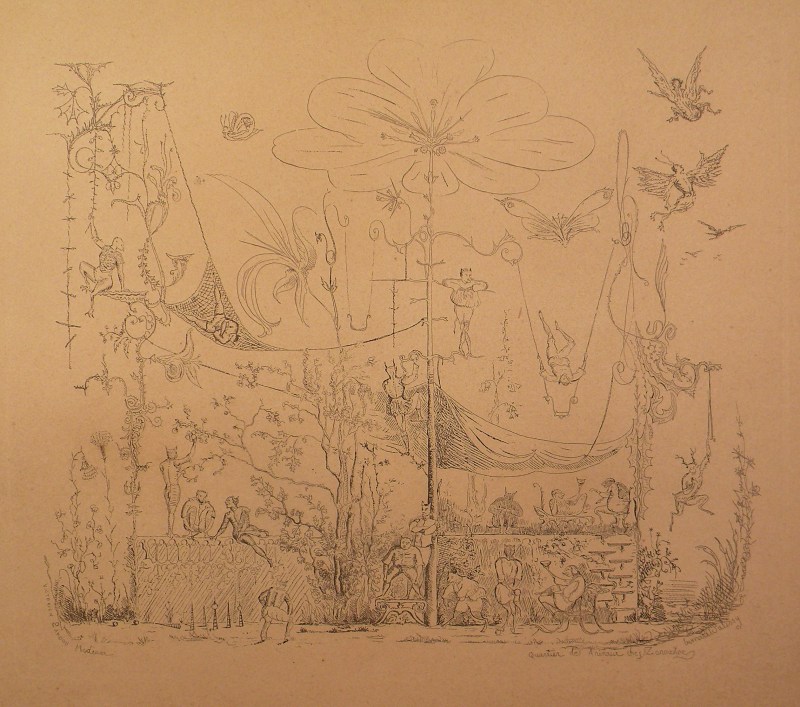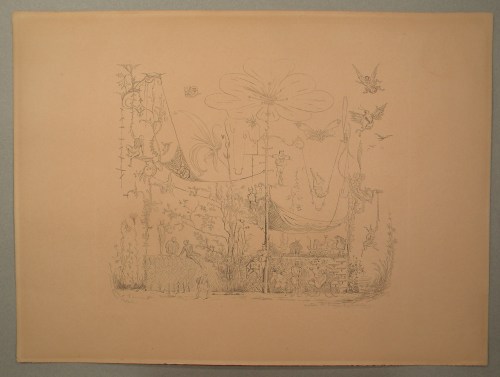Victorien SARDOU: Quartier des Animaux chez Zoroastre - ca. 1860
SOLD
[The animals' quarters at Zoroaster's home]
Etching, 295 x 355 mm. Engraved annotations: VICTORIEN SARDOU Medium bottom left, Quartier des Animaux chez Zoroastre and Bernard Palissy bottom right.
Very fine impression on heavy wove paper. In good condition: two tiny tears (5 mm and 7 mm), repaired, at the upper edge, slight browning of the sheet with a discoloration on 5 mm along the edges. Wide margins (sheet: 404 x 545 mm).
French playwright Victorien Sardou was, like Victor Hugo, a precursor of the so-called clairvoyant art, at a time when in France spiritualism was becoming popular. His etchings were made around the same time as the spiritualist drawings by Victor Hugo. Sardou described himself as a medium, not as the creator of his plates depicting homes where Mozart, Bernard Palissy or Zoroaster were supposed to be living in heaven. According to Sardou, these plates were designed under psychic dictation from Palissy himself (the French 16th century ceramist), whose "signature" is etched on Quartier des Animaux chez Zoroastre.
Sardou explained his method and works in several issues of the Revue Spirite in 1858. In the August issue, he presented his etching La Maison de Mozart, "que Palissy a bien voulu [lui] faire dessiner sur cuivre" [which Palissy was kind enough to make [him] draw on a copperplate]. In the September issue, the founder of the journal, Allan Kardec, explained the method Sardou was supposed to have used: “When we see him at work we easily accept the absence of any premeditated conception or will. His hand, moved by an occult force, gives the pencil or the burin the most irregular motion and the most contrary to the elementary precepts of art: it moves continuously and with an incredible speed from one end of the plate to the other, without leaving it, and returns to the same point a hundred times. In this way, he starts and continues the drawing of each part of the plate at the same time and doesn't complete a part before beginning another. There results a design which looks incoherent at first sight and whose aim becomes intelligible only when the etching is completed”.
This method used by Victorien Sardou to create his "automatic" prints caught the attention of the Surrealists. A proof of La Maison de Mozart was in the collection of André Breton, sold at auction by Calmels-Cohen in April 2003 (lot 4236).
Robert de Montesquiou described Quartier des Animaux chez Zoroastre in a chapter of Roseaux pensants [Thinking reeds] about spiritualist drawings: 'It looks like a design by a crazed Berain [Jean Berain, the 17th century French painter and designer]. A fantastic gymnastics meeting where clowns resemble both the flying man of da Vinci and creations of Blake's. Ariels, Auriols, Leotards, Zemgano brothers, in more or less human shape; a human face with cat’s or kangaroo’s ears; deer’s heads, monkey's tail, insect’s antennae; acrobats, fluttering or suspended in mid-air, in aerial flight between swings, rope ladders and trapezes; standing on historiated stools, reclining on carved tricliniums, sitting in Baroque rocking chairs; under awnings or in hammocks hanging from shrubs whose trunk bears several kinds of foliage. Bowling with a ring-shaped ball; grimaces, disarticulations, flips, crouchings, legs raised. The whole of it under the transparent shelter of an umbel stem.' (Roseaux pensants, Fasquelle, 1897, p. 110, our translation).
The steel plate (in the collection of Mr. and Mrs. Claude de Flers) is reproduced in Entrée des médiums : Spiritisme et Art de Hugo à Breton, catalog of the exhibition held in 2012-2013 at the Maison Victor Hugo in Paris. An impression of Quartier des Animaux chez Zoroastre (abcd collection, Montreuil) was also exhibited (catalog, p. 72).




